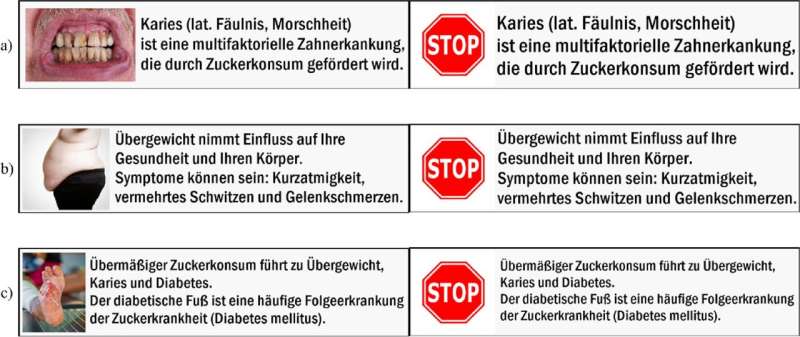This article has been reviewed according to Science X's editorial process and policies. Editors have highlighted the following attributes while ensuring the content's credibility:
fact-checked
peer-reviewed publication
trusted source
proofread
Can product warning labels communicate the dangers of sugar?

Society seems addicted to sugar, but individuals who consume large quantities increase their risk of obesity and other health problems. Can warning labels on sweets curb consumption? Researchers at the University of Göttingen have investigated how such labels can influence purchasing behavior.
Their results show that warnings in the form of images in combination with text can persuade people to buy fewer sugary treats or even to avoid them altogether. Shocking images, similar to those on cigarette packs, are the most effective. Participants in the study who were confronted with such warnings were less willing to buy sweets. The results were published in the journal BMC Public Health.
The researchers carried out an online survey in Germany, collecting responses from over a thousand people over the age of 18 who were part of a sample approximately representative of the German population. Respondents indicated how they perceived different types of warnings about short-term health consequences such as tooth decay, or more long-term consequences such as obesity and type 2 diabetes. Warnings about short-term health problems attracted more attention.
"This may be because the consequences are more immediate," explains Dr. Clara Mehlhose, at Göttingen University's Marketing for Food and Agricultural Products group and first author of the study.
Warnings are therefore worthwhile. However, their design requires a careful approach, emphasizes Mehlhose. "Our results show that warnings are more effective when they use emotional and already familiar symbols or images that are culturally understood. Shocking images and red stop signs have a particularly strong influence on purchasing decisions."
Dr. Antje Risius, from the same research group at Göttingen University and study lead, adds, "We have succeeded in narrowing down and better understanding different reactions and defensive behavior in relation to health warnings."
The study provides important insights for the development of strategies that promote healthy eating and thus improve public health. Future studies will show the impact of health warnings together with other health measures such as a sugar tax.
More information: Clara Mehlhose et al, Effects of immediate and distant health consequences: different types of health warning messages on sweets affect the purchase probability, BMC Public Health (2023). DOI: 10.1186/s12889-023-16760-y




















